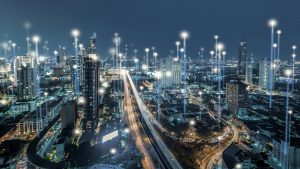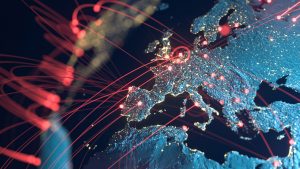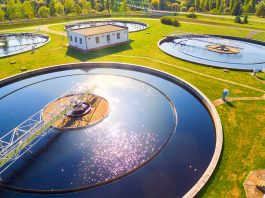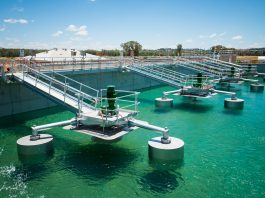Telemaco Melia, Vice President and General Manager of EchoStar Mobile, outlines how water utilities are increasingly turning to new, disruptive processes and technologies to ensure we all get a fair share of our most precious resource.
With a growing global population, now standing at more than eight billion people, ensuring that everyone has enough of the resources needed to support life is a major challenge. One of these essential resources is water. Faced with an increasingly urbanised population, getting potable water to these growing numbers of people, efficiently and sustainably, poses major problems for water utilities. Growing populations have seen demand for fresh water rise rapidly over the last century, increasing six-fold since 1900 to reach four trillion cubic metres per year by the early 21st century.1
Although 70% of the Earth’s surface is covered by it, only 3% of the planet’s water is fresh and therefore drinkable, and most of this is locked up in icecaps. This means that making the most of the small amount that is available to us is essential if we are to meet the challenges we face.
Water scarcity is one of the major factors in the equation. With so little water usable, its distribution and availability become ever more important. This is exacerbated as the climate changes and many landscapes become hotter and dryer while others see more rainfall.
Lack of water in a country leads to a condition of water stress, defined by the World Water Resources Institute as freshwater withdrawals as a percentage of internal (renewable) resources. This means that, if withdrawals are less than 10% of resources, then a country has low water stress. This is the situation in the UK, which has a figure of 5.53%. Greater than 80% is extremely high stress, and some African countries have figures in the hundreds or even thousands of percent.1
Overall, we need to use water more effectively, treat it using the minimum of energy and resources, and distribute it while losing as little as possible through leaks.
To achieve these goals, water utilities are increasingly turning to new, disruptive processes and technologies to ensure we all get a fair share of our most precious resource.
Waste not want not
One of the perennial problems facing water utilities is the leakage of water from pipelines. For example, in the UK, of the total amount of water distributed to consumers, 3,300 megalitres a day escapes through leaks. This amounts to 15 to 25% of the country’s annual production of potable water every year – few other industries could tolerate such a loss.
This poses a serious sustainability issue for water utilities – as well as the lost revenue, there is also the cost of treating more water, with additional energy and chemicals adding to the already significant burden that water treatment places on the environment.
To fix these leaks they must first be detected. This can be difficult, as many leaks, particularly those in remote or rural areas, go undetected and unreported. With a better idea of where leaks are occurring, utilities can send maintenance crews to the exact site of an incident, keeping repair costs and time to a minimum.
One of the ways to detect possible leaks is through continuous flow measurement of a District Metering Area or DMA. This is a small cluster of users that allows monitoring of the water supplied to it. Assessing minimum night-time flows is recommended, because at night, pressure is high, and consumption is low – any losses will be a large proportion of the water entering the system.
This technique requires both a highly accurate flow meter, such as a modern, digitally enabled magnetic flow meter, as well as rapid, robust access to the flow data being captured. Some of the latest flow meters offer connectivity that provides this ready access and flow meter manufacturers are particularly interested in the possibilities offered by the Low Power Wide Area Network (LPWAN) band.

One of the leading protocols is LoRaWAN, the Long Range Wide Area Network technology. Already a global standard, LoRaWAN is currently deployed in 177 countries by 163 network operators with nearly three million gateways.
LoRaWAN is a cost-effective way of sending data over large areas in both cities and rural or wilderness areas. With a range of up to 15km, a battery life measured in years, and penetration both indoors and deep underground, LoRaWAN is ideal for water utilities that may have infrastructure spread out over many hundreds of square kilometres.
This means that however large the water distribution network, and however many flow meters need to be monitored, water managers will always be able to get the data they need to monitor and control leaks.
Many utilities employ LoRaWAN to detect water leaks with acoustic sensors, while also using LoRa-based sensors to help monitor water quality parameters that can include conductivity, chlorine content, and dissolved oxygen.
Water data from space
Some communication network providers offer the option of linking up devices via satellite – using a satellite in geosynchronous orbit, data can be exchanged across continental distances, making it easier to access data from remote areas, underground sites, or in places that pose a risk to installers.
Another possibility for utilities is to use a development of LoRa known as Long Range-Frequency Hopping Spread Spectrum, or LR-FHSS. Compared to conventional LoRa, it offers enhanced data rates, increased network capacity, and additional robustness to interference. LR-FHSS has been used for a solution called Drought Early Warning System for people living on remote islands in the Pacific Ocean. The solution comprises a rainwater tank and rain monitors to analyse water consumption in remote sites in New Zealand and some South Pacific Island communities.
Combining low-cost sensors with LoRa and strong connectivity over satellite, the system helps provide consistent access to clean drinking water for citizens of some of the most remote islands in the world.2
Digital instruments improve efficiency
Faced with rising costs and restricted income, water companies throughout the world need to maximise efficiency and reduce downtime.
Many modern digital water instruments have built-in software that makes them quick and easy to install, configure, and maintain. This allows water utilities to dial into devices and discover their operational status. In this way, the engineer has all the information they need to fix any problem before they reach the site.
These smart digital instruments also help water companies meet the challenges of older, experienced technicians and engineers leaving the industry. Younger engineers are used to the digital world and have skills that fit modern instrumentation and software. For example, many instruments can produce a QR code to indicate their faults. Scanning this code with a smartphone will allow the technician to get diagnostics information, as well as online help from the vendor.
One of the major processes in the supply of potable water is the coagulation stage, which uses aluminium and iron. Getting the dosage rates correct is vital. Coagulants are expensive so overdosing leads to higher costs – by contrast, underdosing means that the end product is not correctly treated. Because digital instruments have a rapid response, processes can be visualised instantly. This ensures that changes in process quality are spotted straight away. As well as saving money, this also prevents anomalous conditions that could cause problems further on in the water treatment process.
The rapid, instant access nature of digital instruments makes them ideal platforms for continuous water quality measurement. Compared to traditional manual sampling, continuous online systems enable samples to be automatically measured and analysed at the sampling point. As well as protecting the water company’s environmental credentials, this also improves productivity by giving real-time indications of current process conditions.
It also cuts out much of the uncertainty and errors of dosage systems that rely on taking a sample to a laboratory for analysis. When combined with the inherent benefits of digital technology, continuous analysers offer a more detailed picture of water quality, as well as greatly improved accuracy and performance.
Water utilities are using reuse to tackle water challenges
One of the major techniques being investigated by utilities to meet their water challenges is water reuse. Conventional water processes involve taking water from rivers or lakes and treating it to meet drinking water standards before distributing it to the public. Water reuse is the treatment of wastewater by removing pollutants – it is then added back into the water sources or even sent directly for consumption.
Two main methods are used – Direct Potable Reuse (DPR) and Indirect Potable Reuse (IPR). DPR creates purified water by adding treated wastewater directly into a municipal water system without using any environmental buffer.
Sited near drinking water and wastewater treatment plants, DPR plants offer the advantage of only needing short pumping distances, making them cost-effective. These short distances also improve water security as DPR systems are unlikely to be affected by external factors such as earthquakes and floods.
The short distances also reduce the energy needed for pumping, cutting the resultant CO2.

IPR works by pumping treated wastewater into an intermediate storage area, such as surface or subsurface reservoirs, with the expectation of using it later as a source of drinking water. The water is reclaimed and treated as normal to bring it up to the standard for human consumption.
In the United States, San Diego imported 85% of its water from Northern California and the Colorado River, taking wastewater discharged from Las Vegas and turning it into over 4.5 million litres of purified water each day.3 Although there are drawbacks, the biggest barrier to the wider use of these techniques is public opinion, which can be suspicious of water it views as inadequately treated.
Waste product or new well of resources?
Increasingly, water utilities are seeing wastewater not as a problem to be solved but as a source of new opportunities. As cities continue to grow, it is important to minimise the consumption of resources and find alternative avenues. To this end, wastewater can be regarded as a valuable commodity. As well as water of different grades for agriculture and industry, it can also produce sludge that can yield energy and biosolids, and phosphorus for fertiliser.
For example, around 20% of manufactured nitrogen and phosphorous is contained in domestic wastewater – because this is concentrated in urban sewerage systems, most of this could be recovered. Typical processes used include evaporation and concentration in one or more evaporators, depending on the materials to be recovered. The product may also be cooled to form salt crystals. A further crystallisation stage allows the separation of the crystals for further processing.
Wastewater also contains 1.3 MJ/person/day (6.5 MJ/kL) of chemical energy, representing 1% of the world’s current total energy consumption, or 4% of the world’s total electricity production. Although this needs a process to convert it into a usable form, it is a concentrated source of carbon that could be better utilised.4
Among the fuels which can be recovered are hydrogen and biodiesel, while bioplastics such as Polyhydroxyalkanoates (PHA) can be formed with inputs from wastewater streams. Widely used in products such as drinking straws, coffee cups, and food containers, PHA offers the great advantage of being bio-degradable.
Energy self-sufficiency
Water treatment is of one the most energy-intensive activities. For example, over 10 billion litres of sewage a day are produced in the UK, taking 6.34 gigawatt hours of energy to treat, almost 1% of the average daily electricity consumption of England and Wales.5
Clearly, water treatment needs to become more energy independent and reduce its carbon footprint. As mentioned above, wastewater is a source of energy, with the main energy contributor in a wastewater treatment plant (WWTP) being the biogas produced in the digester. Using biogas for digester heating and the generation of electricity is seen as a sustainable way of recovering energy from WWTPs. With pre-settling and sludge digestion, a WWTP will on average consume 40% less net energy compared to that without sludge digestion. For example, in the Netherlands, sludge digestion is already in common use. In 2006, this produced 95 million Nm3 of biogas, which was converted in a CHP system to produce 143 MWh of electricity and heat for heating the digestion reactor.6
An example of the success that can be achieved with biogas is the East Bay Municipal Utility District (EBMUD) wastewater facility in Oakland, California. With an average flow rate of 264,979 m3/day, the plant became the first energy-neutral WWTP in North America in 2012.7 This produces 38,000 m3/d of biogas driving a 4.6 MW gas turbine. Producing more than 11 MW of electricity, this meets 126% of the WWTP’s electric power demand, with surpluses supplied to the grid.
Water utilities face immense challenges in treating wastewater and supplying potable water to customers, all while meeting ever-stricter environmental standards. They also need to conduct operations while minimising costs and reducing the use of energy and expensive treatment chemicals.
Meeting these challenges will mean making use of the resources to be found in wastewater, recovering materials that can be sold to other businesses, and harvesting the energy it contains.
Getting more relevant and timely data on their processes will also help utilities operate more efficiently and technologies such as digitally enabled instruments and LoRaWAN connectivity can help achieve this.
With more efficient operations and a lower carbon footprint, water utilities can become more sustainable, ensuring that clean water will continue to be available for everyone.
References
- https://ourworldindata.org/water-use-stress
- https://www.pipelinepub.com/news/New-Zealand-and-South-Pacific-Use-LoRaWAN-for-Drought-Early-Warning-System
- https://www.aquatechtrade.com/news/water-reuse/water-reuse-essential-guide/
- https://www.frontiersin.org/articles/10.3389/fmicb.2016.02106/full
- https://www.parliament.uk/globalassets/documents/post/postpn282.pdf
- https://pdf.sciencedirectassets.com/277910/1-s2.0-S1876610217X00076/1-s2.0-S1876610217309530/main.pdf?X-Amz-Security
- https://reader.elsevier.com/reader/sd/pii/S1876610217309530?token=A7E2EA1F37B9EEB205C033AB3F27944F394B712D81DF1A47A751BA0C332F4E508F70479F4C99911B1880DA3644C9019D&originRegion=eu-west-1&originCreation=20230116095831

Telemaco Melia
Vice President and General Manager
EchoStar Mobile
https://www.echostarmobile.com/
https://www.linkedin.com/in/telemacomelia/
Please note, this article will also appear in the thirteenth edition of our quarterly publication.









